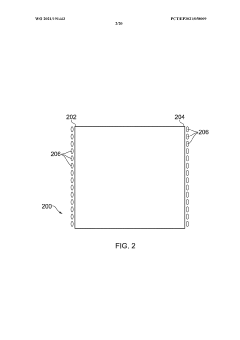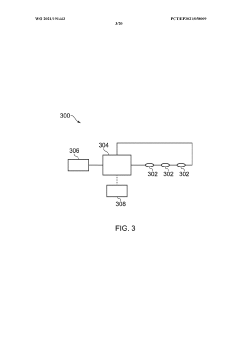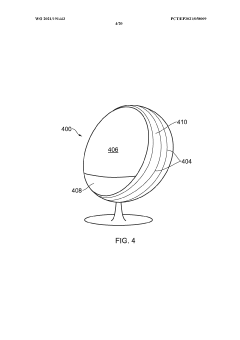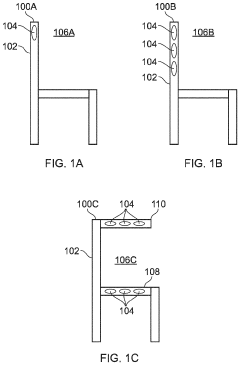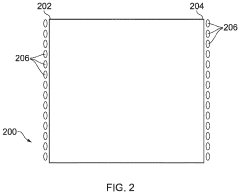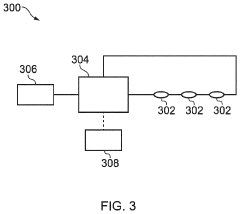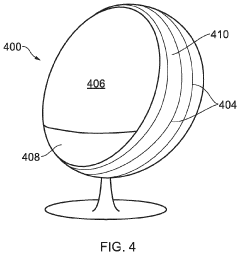Exploring the Implications of Schumann Resonance in Science
JUN 24, 20259 MIN READ
Generate Your Research Report Instantly with AI Agent
Patsnap Eureka helps you evaluate technical feasibility & market potential.
Schumann Resonance Background and Objectives
The Schumann resonance, discovered by physicist Winfried Otto Schumann in 1952, is a set of spectrum peaks in the extremely low frequency (ELF) portion of the Earth's electromagnetic field spectrum. This natural phenomenon occurs due to the resonance of electromagnetic waves within the cavity formed by the Earth's surface and the ionosphere.
The primary objective of exploring the implications of Schumann resonance in science is to gain a deeper understanding of its potential applications and effects on various fields, including atmospheric science, geophysics, and human health. Researchers aim to investigate how these resonances interact with biological systems and their possible influence on Earth's climate and weather patterns.
The development of Schumann resonance research has evolved significantly since its discovery. Initially, it was primarily studied in the context of global electromagnetic phenomena. However, as technology advanced, scientists began to explore its potential applications in diverse areas such as earthquake prediction, lightning detection, and even space weather monitoring.
Recent technological advancements have enabled more precise measurements of Schumann resonances, leading to new insights into their behavior and potential uses. The development of highly sensitive magnetometers and advanced signal processing techniques has allowed researchers to detect subtle variations in these resonances, opening up new avenues for scientific exploration.
One of the key trends in Schumann resonance research is the investigation of its relationship with human physiology and cognition. Some studies suggest a correlation between Schumann resonance frequencies and brain wave patterns, sparking interest in potential applications in fields such as neuroscience and psychology.
The scientific community is also exploring the use of Schumann resonance measurements as a tool for monitoring global climate change. Variations in these resonances may provide insights into large-scale atmospheric processes and help in understanding long-term climate trends.
As research progresses, scientists aim to develop more sophisticated models to predict and analyze Schumann resonance behavior. This includes efforts to understand how human activities, such as urbanization and electromagnetic pollution, might affect these natural frequencies and their potential consequences for Earth's electromagnetic environment.
The primary objective of exploring the implications of Schumann resonance in science is to gain a deeper understanding of its potential applications and effects on various fields, including atmospheric science, geophysics, and human health. Researchers aim to investigate how these resonances interact with biological systems and their possible influence on Earth's climate and weather patterns.
The development of Schumann resonance research has evolved significantly since its discovery. Initially, it was primarily studied in the context of global electromagnetic phenomena. However, as technology advanced, scientists began to explore its potential applications in diverse areas such as earthquake prediction, lightning detection, and even space weather monitoring.
Recent technological advancements have enabled more precise measurements of Schumann resonances, leading to new insights into their behavior and potential uses. The development of highly sensitive magnetometers and advanced signal processing techniques has allowed researchers to detect subtle variations in these resonances, opening up new avenues for scientific exploration.
One of the key trends in Schumann resonance research is the investigation of its relationship with human physiology and cognition. Some studies suggest a correlation between Schumann resonance frequencies and brain wave patterns, sparking interest in potential applications in fields such as neuroscience and psychology.
The scientific community is also exploring the use of Schumann resonance measurements as a tool for monitoring global climate change. Variations in these resonances may provide insights into large-scale atmospheric processes and help in understanding long-term climate trends.
As research progresses, scientists aim to develop more sophisticated models to predict and analyze Schumann resonance behavior. This includes efforts to understand how human activities, such as urbanization and electromagnetic pollution, might affect these natural frequencies and their potential consequences for Earth's electromagnetic environment.
Market Applications of Schumann Resonance
Schumann Resonance, a natural electromagnetic phenomenon occurring in the Earth's ionosphere, has garnered increasing attention for its potential market applications across various industries. The global electromagnetic field (EMF) shielding market, which includes technologies related to Schumann Resonance, is projected to grow significantly in the coming years, driven by the increasing awareness of electromagnetic pollution and its potential health effects.
In the healthcare sector, Schumann Resonance-based therapies are gaining traction as alternative treatments for various conditions. Some medical device manufacturers are developing products that simulate the Earth's natural electromagnetic frequency to promote relaxation, improve sleep quality, and reduce stress. These devices are being marketed as non-invasive solutions for managing anxiety, depression, and other stress-related disorders.
The wellness and fitness industry has also embraced Schumann Resonance technology. Several companies now offer wearable devices and mobile applications that claim to synchronize the user's biorhythms with the Earth's natural frequency. These products are marketed as tools for enhancing meditation practices, improving athletic performance, and promoting overall well-being.
In the field of agriculture, researchers are exploring the potential of Schumann Resonance to enhance crop growth and yield. Some studies suggest that exposing plants to frequencies similar to the Schumann Resonance may stimulate growth, improve nutrient uptake, and increase resistance to pests and diseases. This has led to the development of specialized agricultural equipment designed to generate these frequencies in greenhouses and open fields.
The telecommunications industry is also investigating the implications of Schumann Resonance. Some researchers propose that understanding and harnessing this phenomenon could lead to improved wireless communication systems, particularly in remote areas or during natural disasters when traditional infrastructure may be compromised.
In the realm of environmental monitoring, Schumann Resonance measurements are being used to study global climate patterns and detect potential natural disasters. This has created a niche market for specialized sensors and monitoring equipment designed to detect and analyze these low-frequency electromagnetic waves.
As interest in Schumann Resonance grows, there is an emerging market for educational and research tools related to this phenomenon. Universities and research institutions are investing in equipment to study the Earth's electromagnetic field, creating demand for specialized instruments and software for data analysis and visualization.
While the market applications of Schumann Resonance are diverse and promising, it is important to note that many of these applications are still in the early stages of development and commercialization. The scientific community continues to debate the efficacy and mechanisms of some Schumann Resonance-based technologies, particularly in healthcare applications. As research progresses and regulatory frameworks evolve, the market landscape for Schumann Resonance-related products and services is likely to undergo significant changes in the coming years.
In the healthcare sector, Schumann Resonance-based therapies are gaining traction as alternative treatments for various conditions. Some medical device manufacturers are developing products that simulate the Earth's natural electromagnetic frequency to promote relaxation, improve sleep quality, and reduce stress. These devices are being marketed as non-invasive solutions for managing anxiety, depression, and other stress-related disorders.
The wellness and fitness industry has also embraced Schumann Resonance technology. Several companies now offer wearable devices and mobile applications that claim to synchronize the user's biorhythms with the Earth's natural frequency. These products are marketed as tools for enhancing meditation practices, improving athletic performance, and promoting overall well-being.
In the field of agriculture, researchers are exploring the potential of Schumann Resonance to enhance crop growth and yield. Some studies suggest that exposing plants to frequencies similar to the Schumann Resonance may stimulate growth, improve nutrient uptake, and increase resistance to pests and diseases. This has led to the development of specialized agricultural equipment designed to generate these frequencies in greenhouses and open fields.
The telecommunications industry is also investigating the implications of Schumann Resonance. Some researchers propose that understanding and harnessing this phenomenon could lead to improved wireless communication systems, particularly in remote areas or during natural disasters when traditional infrastructure may be compromised.
In the realm of environmental monitoring, Schumann Resonance measurements are being used to study global climate patterns and detect potential natural disasters. This has created a niche market for specialized sensors and monitoring equipment designed to detect and analyze these low-frequency electromagnetic waves.
As interest in Schumann Resonance grows, there is an emerging market for educational and research tools related to this phenomenon. Universities and research institutions are investing in equipment to study the Earth's electromagnetic field, creating demand for specialized instruments and software for data analysis and visualization.
While the market applications of Schumann Resonance are diverse and promising, it is important to note that many of these applications are still in the early stages of development and commercialization. The scientific community continues to debate the efficacy and mechanisms of some Schumann Resonance-based technologies, particularly in healthcare applications. As research progresses and regulatory frameworks evolve, the market landscape for Schumann Resonance-related products and services is likely to undergo significant changes in the coming years.
Current State and Challenges in Schumann Resonance Research
Schumann resonance research has made significant strides in recent years, yet it continues to face several challenges. The current state of this field is characterized by a blend of established knowledge and emerging questions that demand further investigation.
One of the primary advancements in Schumann resonance research is the improvement in measurement techniques. High-sensitivity magnetometers and advanced signal processing algorithms have enhanced our ability to detect and analyze these low-frequency electromagnetic waves. This has led to more accurate measurements of the fundamental frequency and its harmonics, providing a clearer picture of the Earth-ionosphere cavity's electromagnetic properties.
However, despite these improvements, researchers still grapple with the challenge of isolating Schumann resonance signals from background noise. The extremely low frequency of these resonances makes them susceptible to interference from both natural and anthropogenic sources. This necessitates the development of more sophisticated noise reduction techniques to ensure the reliability of collected data.
Another significant area of progress is the growing understanding of the relationship between Schumann resonances and global lightning activity. Recent studies have demonstrated a strong correlation between variations in Schumann resonance parameters and global lightning patterns, offering potential insights into climate change and severe weather events.
Nonetheless, the interpretation of these correlations remains a complex task. The multifaceted nature of the Earth-ionosphere system, influenced by various geophysical and solar phenomena, presents a considerable challenge in isolating the specific effects of Schumann resonances on atmospheric processes.
The application of Schumann resonance measurements in fields such as space weather monitoring and earthquake prediction has gained traction. However, the mechanisms linking these phenomena to Schumann resonances are not fully understood, limiting their predictive power and practical applications.
A persistent challenge in the field is the limited global coverage of Schumann resonance monitoring stations. While there has been an increase in the number of observation points, large areas of the Earth, particularly over oceans and in remote regions, remain underrepresented. This geographical bias in data collection hinders our ability to construct a comprehensive global model of Schumann resonance behavior.
Furthermore, the interdisciplinary nature of Schumann resonance research presents both opportunities and challenges. Integrating knowledge from atmospheric physics, geophysics, and electromagnetic theory requires collaboration across diverse scientific domains. While this interdisciplinary approach has led to novel insights, it also highlights the need for a unified theoretical framework to explain the various observed phenomena.
One of the primary advancements in Schumann resonance research is the improvement in measurement techniques. High-sensitivity magnetometers and advanced signal processing algorithms have enhanced our ability to detect and analyze these low-frequency electromagnetic waves. This has led to more accurate measurements of the fundamental frequency and its harmonics, providing a clearer picture of the Earth-ionosphere cavity's electromagnetic properties.
However, despite these improvements, researchers still grapple with the challenge of isolating Schumann resonance signals from background noise. The extremely low frequency of these resonances makes them susceptible to interference from both natural and anthropogenic sources. This necessitates the development of more sophisticated noise reduction techniques to ensure the reliability of collected data.
Another significant area of progress is the growing understanding of the relationship between Schumann resonances and global lightning activity. Recent studies have demonstrated a strong correlation between variations in Schumann resonance parameters and global lightning patterns, offering potential insights into climate change and severe weather events.
Nonetheless, the interpretation of these correlations remains a complex task. The multifaceted nature of the Earth-ionosphere system, influenced by various geophysical and solar phenomena, presents a considerable challenge in isolating the specific effects of Schumann resonances on atmospheric processes.
The application of Schumann resonance measurements in fields such as space weather monitoring and earthquake prediction has gained traction. However, the mechanisms linking these phenomena to Schumann resonances are not fully understood, limiting their predictive power and practical applications.
A persistent challenge in the field is the limited global coverage of Schumann resonance monitoring stations. While there has been an increase in the number of observation points, large areas of the Earth, particularly over oceans and in remote regions, remain underrepresented. This geographical bias in data collection hinders our ability to construct a comprehensive global model of Schumann resonance behavior.
Furthermore, the interdisciplinary nature of Schumann resonance research presents both opportunities and challenges. Integrating knowledge from atmospheric physics, geophysics, and electromagnetic theory requires collaboration across diverse scientific domains. While this interdisciplinary approach has led to novel insights, it also highlights the need for a unified theoretical framework to explain the various observed phenomena.
Existing Measurement and Analysis Techniques
01 Schumann resonance devices for health and wellness
Various devices are designed to generate or utilize Schumann resonance frequencies for potential health benefits. These devices aim to simulate the natural electromagnetic frequencies of the Earth to promote relaxation, improve sleep quality, and enhance overall well-being. Some implementations include wearable devices, room-based generators, and portable units that emit Schumann resonance frequencies.- Schumann resonance devices for health and wellness: Various devices are designed to generate or utilize Schumann resonance frequencies for potential health benefits. These devices aim to simulate the natural electromagnetic frequencies of the Earth to promote relaxation, improve sleep quality, and enhance overall well-being. Some implementations include wearable devices, room-based generators, and portable units that emit Schumann resonance frequencies.
- Schumann resonance in environmental monitoring and research: Schumann resonance is utilized in environmental monitoring and research applications. Devices and systems are developed to measure and analyze these resonances for studying global electromagnetic phenomena, climate change effects, and potential earthquake prediction. These applications often involve sensitive sensors and data processing algorithms to detect and interpret Schumann resonance signals.
- Integration of Schumann resonance in meditation and relaxation products: Schumann resonance frequencies are incorporated into various meditation and relaxation products. These include specialized audio devices, meditation cushions, and relaxation chambers that generate or amplify Schumann resonance frequencies. The aim is to create an environment that resonates with the Earth's natural frequencies, potentially enhancing meditation practices and promoting deeper relaxation states.
- Schumann resonance in electromagnetic shielding and protection: Innovations in electromagnetic shielding and protection incorporate Schumann resonance principles. These include devices and materials designed to protect against harmful electromagnetic frequencies while allowing beneficial Schumann resonances to pass through. Applications range from personal protective equipment to building materials that aim to create healthier living and working environments.
- Schumann resonance applications in agriculture and plant growth: Schumann resonance is explored for potential benefits in agriculture and plant growth. Devices and systems are developed to expose plants to Schumann resonance frequencies, aiming to enhance growth, improve crop yields, and increase plant resilience. These applications often involve specialized growth chambers or field-based emitters that generate or amplify Schumann resonance frequencies in agricultural settings.
02 Schumann resonance in electromagnetic shielding
Schumann resonance principles are applied in the development of electromagnetic shielding materials and structures. These innovations aim to protect electronic devices and living spaces from harmful electromagnetic radiation while maintaining the beneficial effects of natural Earth frequencies. Some designs incorporate Schumann resonance-tuned materials or structures into building elements, clothing, or device casings.Expand Specific Solutions03 Schumann resonance in energy harvesting and power generation
Researchers are exploring ways to harness Schumann resonance frequencies for energy harvesting and power generation. These technologies aim to convert the Earth's natural electromagnetic oscillations into usable electrical energy. Potential applications include powering small electronic devices, sensors, or contributing to renewable energy systems.Expand Specific Solutions04 Schumann resonance in communication and signal processing
Schumann resonance frequencies are being utilized in novel communication systems and signal processing techniques. These innovations aim to improve long-distance communication, enhance signal quality in challenging environments, or develop new methods for data transmission. Some applications include underwater communication, through-earth signaling, and low-frequency data encoding.Expand Specific Solutions05 Schumann resonance measurement and monitoring devices
Advanced instruments and systems are being developed to measure and monitor Schumann resonance frequencies with high precision. These devices are used for scientific research, environmental monitoring, and potential applications in earthquake prediction or space weather forecasting. Some implementations include portable sensors, global monitoring networks, and data analysis systems.Expand Specific Solutions
Key Players in Schumann Resonance Research
The exploration of Schumann Resonance implications in science is currently in an emerging phase, with growing interest across various disciplines. The market size for related research and applications is expanding, driven by potential applications in fields such as atmospheric science, biophysics, and telecommunications. Technologically, the field is still developing, with varying levels of maturity among key players. Companies like Koninklijke Philips NV and Intel Corp. are leveraging their technological expertise to explore potential applications, while academic institutions such as Hangzhou Dianzi University, University of Bern, and Zhejiang University are contributing to fundamental research. Collaborative efforts between industry and academia, exemplified by partnerships involving entities like Japan Science & Technology Agency, are accelerating progress in understanding and harnessing Schumann Resonance phenomena.
Max Planck Gesellschaft zur Förderung der Wissenschaften eV
Technical Solution: Max Planck Society has been at the forefront of Schumann resonance research, developing advanced detection and analysis techniques. Their approach involves using high-sensitivity magnetometers and sophisticated signal processing algorithms to isolate and study Schumann resonances. They have also developed models to correlate these resonances with various atmospheric and ionospheric phenomena, contributing significantly to our understanding of Earth's electromagnetic environment and its potential impacts on climate and biological systems.
Strengths: World-class research facilities and expertise in atmospheric physics. Weaknesses: Limited direct commercial applications of the research.
The University of Southampton
Technical Solution: The University of Southampton has been actively researching Schumann resonances through its Space Environment Physics group. Their approach combines theoretical modeling with experimental observations using both ground-based and satellite measurements. They have developed sophisticated numerical models to simulate the Earth-ionosphere cavity and its response to various geophysical phenomena. The university has also been investigating the potential use of Schumann resonances as a tool for monitoring global lightning activity and its relationship to climate change. Additionally, they are exploring the possible effects of Schumann resonances on space weather and their potential impact on satellite communications.
Strengths: Strong expertise in space physics and atmospheric electricity. Weaknesses: Limited focus on biological implications of Schumann resonances.
Core Innovations in Schumann Resonance Detection
A magnetic field exposure system and uses thereof
PatentWO2021191443A1
Innovation
- A magnetic field exposure system generating an amplitude-modulated low frequency magnetic field with a carrier frequency of 360 to 450 Hz and a modulation frequency of 0.5 to 100 Hz, with a field strength of 0.5 to 250 mT, specifically designed to expose organic cells or tissues to improve cell survival, proliferation, reduce stress, and enhance well-being.
A magnetic field exposure system and uses thereof
PatentPendingUS20230372726A1
Innovation
- A magnetic field exposure system generating an amplitude-modulated low frequency magnetic field with a carrier frequency of 360 to 450 Hz and a modulation frequency of 0.5 to 100 Hz, providing a field strength of 0.5 to 250 μT, specifically designed to enhance cell survival, proliferation, reduce stress, and promote tissue regeneration.
Environmental Factors Affecting Schumann Resonance
The Schumann resonance, a set of spectrum peaks in the extremely low frequency (ELF) portion of the Earth's electromagnetic field spectrum, is influenced by various environmental factors. These factors play a crucial role in modulating the resonance's characteristics and have significant implications for scientific research and applications.
One of the primary environmental factors affecting Schumann resonance is global lightning activity. As the main excitation source of the Earth-ionosphere cavity, variations in lightning occurrence and intensity directly impact the resonance's amplitude and frequency. Seasonal changes in lightning distribution, particularly the shift of thunderstorm activity between the Northern and Southern hemispheres, lead to observable fluctuations in Schumann resonance parameters.
Solar activity also exerts a considerable influence on Schumann resonance. Solar flares and coronal mass ejections can cause disturbances in the ionosphere, altering its conductivity and height. These changes affect the propagation of electromagnetic waves within the Earth-ionosphere cavity, resulting in variations in Schumann resonance frequencies and amplitudes. The 11-year solar cycle has been observed to correlate with long-term changes in Schumann resonance characteristics.
Atmospheric conditions, including temperature, humidity, and pressure, contribute to the modulation of Schumann resonance. These factors affect the conductivity of the lower atmosphere and influence the propagation of electromagnetic waves. For instance, changes in the water vapor content of the atmosphere can alter the attenuation of ELF waves, impacting the observed Schumann resonance signals.
Geomagnetic activity, driven by interactions between the Earth's magnetic field and the solar wind, also plays a role in shaping Schumann resonance. Geomagnetic storms can cause significant perturbations in the ionosphere, leading to temporary changes in the resonance's properties. These effects are particularly pronounced at high latitudes, where geomagnetic activity is more intense.
Human activities, such as urbanization and industrialization, contribute to local and regional electromagnetic noise that can interfere with Schumann resonance measurements. The increasing prevalence of power lines, wireless communications, and other electromagnetic sources in populated areas poses challenges for accurate detection and analysis of Schumann resonance signals.
Climate change and its associated phenomena, including shifts in global temperature patterns and extreme weather events, may have long-term effects on Schumann resonance. Changes in the frequency and distribution of thunderstorms, as well as alterations in atmospheric composition, could lead to subtle but measurable changes in the resonance over time.
Understanding these environmental factors and their complex interactions is crucial for interpreting Schumann resonance data accurately. This knowledge enables scientists to use Schumann resonance as a tool for monitoring global climate patterns, studying ionospheric dynamics, and potentially developing early warning systems for natural disasters.
One of the primary environmental factors affecting Schumann resonance is global lightning activity. As the main excitation source of the Earth-ionosphere cavity, variations in lightning occurrence and intensity directly impact the resonance's amplitude and frequency. Seasonal changes in lightning distribution, particularly the shift of thunderstorm activity between the Northern and Southern hemispheres, lead to observable fluctuations in Schumann resonance parameters.
Solar activity also exerts a considerable influence on Schumann resonance. Solar flares and coronal mass ejections can cause disturbances in the ionosphere, altering its conductivity and height. These changes affect the propagation of electromagnetic waves within the Earth-ionosphere cavity, resulting in variations in Schumann resonance frequencies and amplitudes. The 11-year solar cycle has been observed to correlate with long-term changes in Schumann resonance characteristics.
Atmospheric conditions, including temperature, humidity, and pressure, contribute to the modulation of Schumann resonance. These factors affect the conductivity of the lower atmosphere and influence the propagation of electromagnetic waves. For instance, changes in the water vapor content of the atmosphere can alter the attenuation of ELF waves, impacting the observed Schumann resonance signals.
Geomagnetic activity, driven by interactions between the Earth's magnetic field and the solar wind, also plays a role in shaping Schumann resonance. Geomagnetic storms can cause significant perturbations in the ionosphere, leading to temporary changes in the resonance's properties. These effects are particularly pronounced at high latitudes, where geomagnetic activity is more intense.
Human activities, such as urbanization and industrialization, contribute to local and regional electromagnetic noise that can interfere with Schumann resonance measurements. The increasing prevalence of power lines, wireless communications, and other electromagnetic sources in populated areas poses challenges for accurate detection and analysis of Schumann resonance signals.
Climate change and its associated phenomena, including shifts in global temperature patterns and extreme weather events, may have long-term effects on Schumann resonance. Changes in the frequency and distribution of thunderstorms, as well as alterations in atmospheric composition, could lead to subtle but measurable changes in the resonance over time.
Understanding these environmental factors and their complex interactions is crucial for interpreting Schumann resonance data accurately. This knowledge enables scientists to use Schumann resonance as a tool for monitoring global climate patterns, studying ionospheric dynamics, and potentially developing early warning systems for natural disasters.
Interdisciplinary Implications of Schumann Resonance
The Schumann resonance, a set of spectrum peaks in the extremely low frequency (ELF) portion of the Earth's electromagnetic field spectrum, has far-reaching implications across various scientific disciplines. This phenomenon, first predicted by Winfried Otto Schumann in 1952, has become a focal point for interdisciplinary research, bridging the gap between geophysics, atmospheric science, and human biology.
In the field of geophysics, Schumann resonance serves as a valuable tool for monitoring global lightning activity and studying the Earth's ionosphere. Researchers use these resonances to track changes in the lower ionosphere's conductivity, which can be influenced by solar activity, seasonal variations, and even human-induced factors. This application extends to climate science, where long-term monitoring of Schumann resonances may provide insights into global climate patterns and their evolution over time.
Atmospheric scientists leverage Schumann resonance data to investigate the complex interactions between the Earth's surface and the ionosphere. These studies contribute to our understanding of atmospheric electricity, thunderstorm dynamics, and the global electric circuit. Moreover, the resonances offer a unique perspective on the vertical structure of the atmosphere, complementing other measurement techniques and enhancing our ability to model atmospheric processes accurately.
In the realm of human biology and neuroscience, the Schumann resonance has sparked intriguing research into potential correlations between these natural electromagnetic frequencies and human brain activity. Some studies suggest that the human brain may be tuned to resonate with these Earth-generated frequencies, potentially influencing circadian rhythms, cognitive function, and overall well-being. While these findings remain controversial, they have opened new avenues for exploring the intricate relationships between environmental electromagnetic fields and human physiology.
The interdisciplinary nature of Schumann resonance research extends to space weather studies, where these resonances serve as indicators of solar-terrestrial interactions. By monitoring changes in Schumann resonance parameters, scientists can detect and study the effects of solar flares, coronal mass ejections, and other space weather phenomena on the Earth's upper atmosphere and ionosphere.
Furthermore, the study of Schumann resonances has implications for telecommunications and navigation systems. Understanding these natural electromagnetic oscillations is crucial for designing and optimizing long-range communication systems that utilize the Earth-ionosphere waveguide. This knowledge also contributes to improving the accuracy and reliability of global navigation satellite systems by accounting for ionospheric disturbances that can affect signal propagation.
In the field of geophysics, Schumann resonance serves as a valuable tool for monitoring global lightning activity and studying the Earth's ionosphere. Researchers use these resonances to track changes in the lower ionosphere's conductivity, which can be influenced by solar activity, seasonal variations, and even human-induced factors. This application extends to climate science, where long-term monitoring of Schumann resonances may provide insights into global climate patterns and their evolution over time.
Atmospheric scientists leverage Schumann resonance data to investigate the complex interactions between the Earth's surface and the ionosphere. These studies contribute to our understanding of atmospheric electricity, thunderstorm dynamics, and the global electric circuit. Moreover, the resonances offer a unique perspective on the vertical structure of the atmosphere, complementing other measurement techniques and enhancing our ability to model atmospheric processes accurately.
In the realm of human biology and neuroscience, the Schumann resonance has sparked intriguing research into potential correlations between these natural electromagnetic frequencies and human brain activity. Some studies suggest that the human brain may be tuned to resonate with these Earth-generated frequencies, potentially influencing circadian rhythms, cognitive function, and overall well-being. While these findings remain controversial, they have opened new avenues for exploring the intricate relationships between environmental electromagnetic fields and human physiology.
The interdisciplinary nature of Schumann resonance research extends to space weather studies, where these resonances serve as indicators of solar-terrestrial interactions. By monitoring changes in Schumann resonance parameters, scientists can detect and study the effects of solar flares, coronal mass ejections, and other space weather phenomena on the Earth's upper atmosphere and ionosphere.
Furthermore, the study of Schumann resonances has implications for telecommunications and navigation systems. Understanding these natural electromagnetic oscillations is crucial for designing and optimizing long-range communication systems that utilize the Earth-ionosphere waveguide. This knowledge also contributes to improving the accuracy and reliability of global navigation satellite systems by accounting for ionospheric disturbances that can affect signal propagation.
Unlock deeper insights with Patsnap Eureka Quick Research — get a full tech report to explore trends and direct your research. Try now!
Generate Your Research Report Instantly with AI Agent
Supercharge your innovation with Patsnap Eureka AI Agent Platform!

